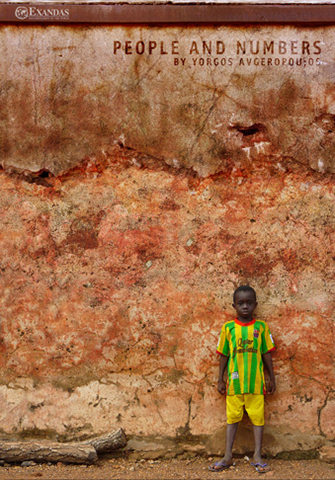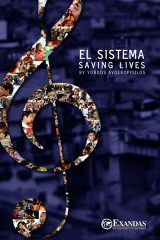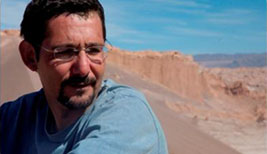
People and Numbers
Dir: Yorgos AvgeropoulosAccording to the IMF, Ghana is a case of success! The government, after faithfully following the IMF’s recommendations for shrinking the public sector, fully liberalizing the market and carrying out privatizations, has now “achieved its goals”. Nowadays, the country’s economy is among the world’s 20 fastest growing economies and the first in Africa!
However at the same time, 4,000 schools do not have any facilities and the students are having their lessons under the trees. At the clinics in the country’s northern parts there is one doctor per 161,000 inhabitants! And small scale farmers, without any support from the state, have been left to starve, struggling alone in the free market’s vast sea.
Growth… for whom?
Watch the Film Now!
Choose the language you prefer and stream the film in Full HD from any digital device. Enjoy your private screening!
Buy the DVD
€11,04
Public Screening
Are you interested in organizing a public screening of our film? Send us an email with your inquiry and we will be glad to assist you!
Educational / Library Use
Are you interested in enriching the library of your institution with our film? Contact us and let's create together an informed public!
- DURATION: 48min
- AVAILABLE IN THE FOLLOWING LANGUAGES: English | Greek
- AVAILABLE VERSIONS: English (48min) | Greek (48min)
- YEAR OF PRODUCTION: 2012
- Written & Directed by : Yorgos Avgeropoulos
- Produced by : Achilleas Kouremenos
- Director of Photography: Vasilis Mourikis
- Production Manager: Anastasia Skoubri
- Research Coordinator: Georgia Anagnou
- Editing: Anna Prokou, Vasilis Magkos
- Original Music: Yiannis Paxevanis
PRODUCTION NOTES
“To be a poor man is hard, but to be a poor race in a land of dollars is the very bottom of hardships.”
W.E.B. DuBois
Ghana’s economy is thriving! In the capital of Accra, dozens of cranes rise in the horizon, constructing new, modern buildings, which will house offices of banks, multinational and local firms. The boom in the construction sector is evident in the new, good neighborhoods, which are surrounded by fences and barbed wires, as well as in the shopping centers that keep sprouting one after the other.
Since 2000, Ghana has been developing with an average yearly rate of 5%, until in 2011 it reached 14.4%. Thanks to the profits from gold, which are the country’s driving force (Ghana is Africa’s second largest gold producer and fifth in the world), the profits from cacao and recently from oil, together with the help from the IMF and the government’s reforms, Ghana has become –at least in numbers- a medium income country and Africa’s ninth country to reach this position.
“The politics followed are a success!”, confirms IMF’s resident representative for Ghana, Samir Jahjah. “It is evident in recent years that Ghana has managed to create an environment of macroeconomic stability, which is necessary for there to be investments, development and creation of new working positions”.
However, how is the population experiencing this growth?
According to a 2012 opinion poll by Gallop, 53% of the population, approximately 12.7 million people, cannot afford the cost of food. Only 4% did state that it is living comfortably with its income. Almost 30% are still living under conditions of extreme poverty.
“We have growth in the agricultural sector, in the service industry, at hospitals and in education”, points out IMF’s resident representative for Ghana, Samir Jahjah.
EVERY TREE AND A CLASSROOM
Ghana’s northern provinces are the country’s most deprived areas. Huge billboards with advertisements from mobile companies cover the houses’ walls, which are built with bricks made of mud. The roads are bad. In many boroughs there is no drinking water and no electricity. People are forced to travel from their boroughs to the cities, spending thus a whole day just to charge their mobile phones. Even in the big cities drainage infrastructures are rare, magnifying the danger of contracting diseases and infections.
Just outside Bolgatanga there is a primary school were 291 children attend.
Every tree is a classroom.
Dozens of children sit on rows of benches that are situated beneath a tree. There is a blackboard placed on the tree’s trunk. A parent, who is also a volunteer teacher, tries to teach the children the English alphabet.
“Whenever it rains, or when it is just threatening to rain, we tell the children to leave and go home. And when it is February – March, there is no shade and we all gather in the only existing room, where we sweat a lot”, describes Comfort, the school’s only teacher. “The sun is hot and we must sit under the trees. Sometimes the wind throws the blackboard on us and we get injured”, describes the ten-year-old student Zeynab.
The cutbacks in the public sector, which were one of the IMF’s conditions for proceeding to the 2009 new borrowing agreement, have deeply affected Ghana’s public education sector. And the reason for this is that the government in its efforts to reach the goals for reducing the deficit has decided to cut back 31 millions from education.
Africa’s second largest gold producer and the fifth in the world, is unable to provide classrooms for thousands of children. In the whole of Ghana, 4,000 schools lack the necessary facilities. “Usually when we complain, the answer we get is that there are too many schools and there are not enough resources for all the schools in Ghana operating under the trees”, explains Comfort.
However, the lack of buildings is not the only problem for the children.
The recruitment freeze in the public sector, another one of the IMF’s stipulations for signing the borrowing agreement, had an immediate impact on the quality of education in Ghana. According to the country’s Education department, in order to cover the teacher shortage alone in primary schools, 33,185 teachers are needed, something that will never be approved. In Ghana’s northern regions, there is one trained teacher like Comfort for every 175 pupils.
And the problems do not end here. In Africa’s first developing country, children often have to walk 5 kilometers to reach their schools, while back at home electricity is considered a luxury. “I read with a flashlight, since the community has no electricity. It is difficult to read like that, because many times another family member needs the flashlight and I have to wait until they finish what they are doing”, describes Zeynab, a young schoolgirl.
ONE DOCTOR PER 161,000 PEOPLE
Further in the North, in the city of Zebilla that lies near the borders with Burkina Faso, we met with a young nurse, Gifti. She is just 26 years old and is one of the two nurses in the clinic that caters for the needs of 7 communities and approximately 3,000 people. Not only does she care for the people who come to the clinic, but many times she travels on her motorbike to the communities in order to care for the pregnant women. “We have motorbikes, which we use to go there. Sometimes when they break down, we realize that most women give birth at home, because we cannot be there.”
The shortage in clinics and doctors, the difficulty reaching those, the deficiency in infrastructures and medicines, as well as the problems in education that lead to the population’s ignorance concerning various diseases, make health care very difficult. “I know that elsewhere a mother’s death is a crisis, an emergency situation. But here, in the 40 weeks of the year we have recorded in one area 93 deaths of women in childbirth. It is undoubtedly unacceptable!”, discloses Alhaji Abdulrahman Yakubu, Northern Ghana’s district health director.
Simple cases of infections or ordinary diseases can lead to death. And many times it is just a simple matter of antibiotics, simple care from a doctor or a nurse. “There is one nurse for every 2,600 people. The percentage corresponding to midwives is even greater. Also, allow me to say that we have one doctor per 161,000 people, which is obviously not the best condition. One doctor responsible for more than 161,000 people!”, Mr. Yakubu points out indignantly.
The government official, however, does not respond in the same manner when we ask him about the causes for these deficiencies or the ways in which this problem could be solved. He merely overemphasizes the government’s previous mosquito net campaign that even provided farmers with tacks and hammers to fasten them over their beds. He also adds that many immigrants, who come from the neighboring countries carrying diseases, are the ones responsible for making the government’s work even more difficult.
Although the mosquito nets’ usefulness in combating malaria should not be underestimated, young nurse Gifti is identifying the issues more aptly: “I believe that there is money and that it should be invested in Healthcare. Because if you are not healthy, I don’t believe that our communities can develop. If, for example, the sphygmomanometer breaks down today, because we only have one, the patients, who will come today, will not be treated, unless they bring a new one with them. We cannot treat them without checking their blood pressure. Also, the building is in bad condition. The plasters are constantly falling off. I think it is because of the rain. If you have no facilities, how can you work? That is what is important to me.
What do we want from the government? We ask for drinking water, not just for us, but for the whole community”.
Against the simplicity of the above mentioned problems, the government official thanks God that Europe is facing an economic crisis and young doctors and nurses immigrate less. “The doctors and nurses became fewer in numbers, because they left Ghana for the developed world, for Europe and the US. But thank God, Ghana’s government realized this and thank God, Europe is facing a financial meltdown and our nurses don’t find working positions there, like they used to”.
SMALL SCALE FARMERS IN THE MIDST OF WTO IMPERATIVES
Agriculture is one of Ghana’s most important production sectors. However, here in the North, it is the only way to survive. At the center of Northern Ghana’s capital, Tamale, dozens of women gather and process the rice. “It is very difficult for our rice to reach the market”, they say, attributing the causes to rice import from neighboring countries. “We pray that the government will stop importing rice. When it stops importing, our rice will be offered on the market”, complains Auabu.
“According to the World Trade Organization’s stipulations, we cannot reduce the import of certain products. If there was a law restricting the import of those products, our farmers would sell competitively”, points out James Ouama, ActionAid’s manager for agricultural growth.
However, this is not the only problem. “The Ministry of Agriculture used to provide us with fertilizers, but now they have stopped. I don’t understand why the government is not supporting us”, wonders farmer Sok Kabe.
The WTO’s regulations have rendered the products from small producers uncompetitive. The government, while making cutbacks in the public sector, has also been making subsidy cuts. “The government cuts back on the means, on the subsidies, on research, on technological development. They cut back on everything”, says Gyekye Tanoh of Third World Network Africa. “And all this is available at market prices. The small scale farmer cannot buy these things and cannot produce. S/he has been excluded.”
Miss Auabu says vividly: “When you do not sell, you have no profit. How can you feed your family? You don’t have any money. And if you don’t have any money, how can you feed your family? We suffer and we don’t receive any money. We always suffer and in the end we never succeed!”
GROWTH FOR WHOM?
Ghana is a veteran as far as IMF’s “rescue plans” are concerned. Since 1957, when it gained its independence from the English, and until now, it has a love and hate relation to the IMF. Since 1966, five governments, which have been alternating as the coups in this country have, have requested loans.
The last borrowing agreement was in 2009 for the sum of 602 million dollars. Ghana’s government debt soared to historic heights reaching 14.6 billion dollars (23.4 Ghanaian cedi).
Without a doubt these loans helped the country’s economy to explode and resemble a galloping economic steed. However, the benefits of growth have not been felt by the vast majority of the population, which is left to struggle daily for survival, while required at the same time to repay the successive loans the government received from the IMF.
In real life, the numbers certainly are not consistent with the jubilant atmosphere that exists in the official economic and political institutions of the country brought upon by successful economic indicators.
“No child in Ghana should be undernourished, no child should go to bed hungry, all children should have access to education. These are the things we should look at in order to measure what true growth is”, insists Adwoa Kwateng-Kluvitse, director of ActionAid Ghana.“In the lean seasons, women eat last and least. And when it gets really bad they may eat once every day, once every two days, so that their children can eat. And these I think should be the real indicators of what a middle income economy is. Is any woman dying in childbirth? Avoidably that should be an indicator. Are women able to access the health services, the education services, the markets? That should be the real indicator of what growth is!”







